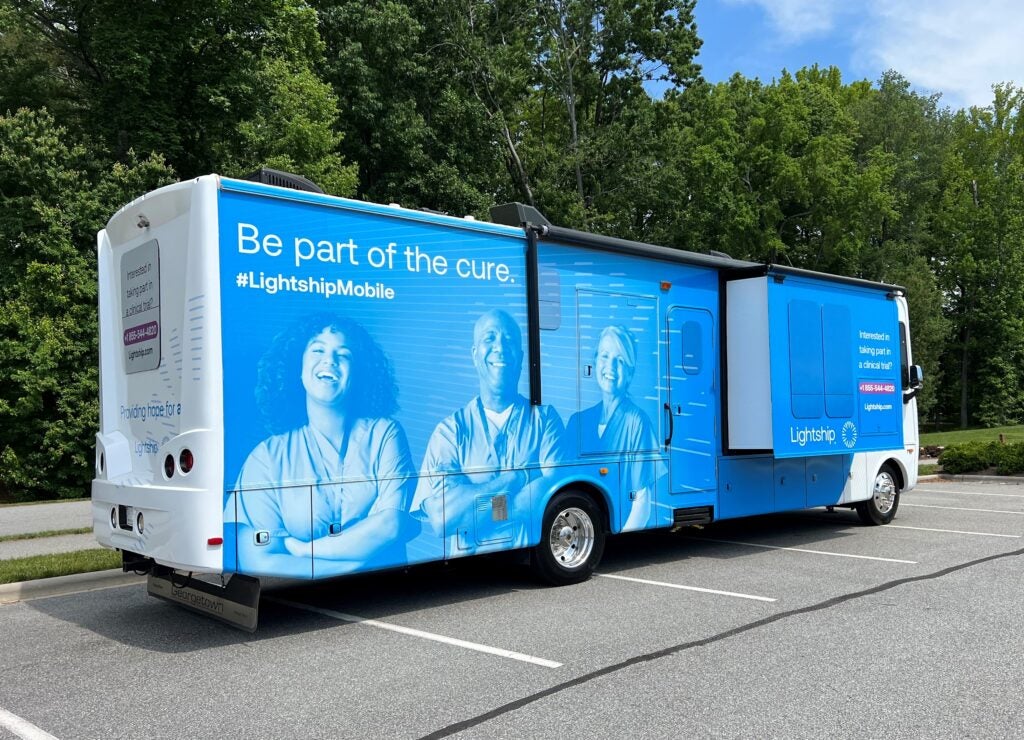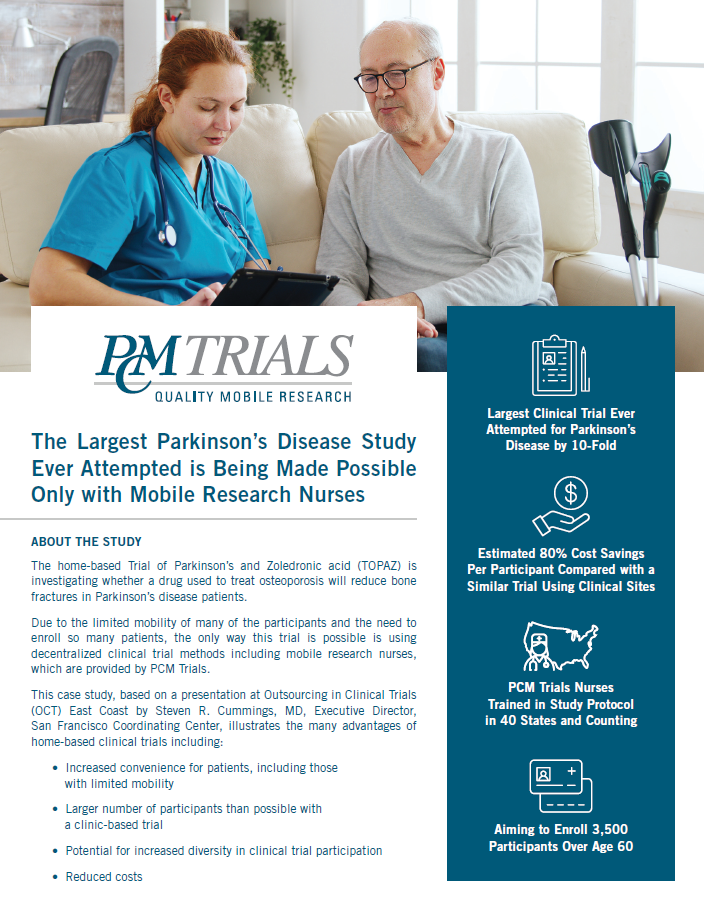Clinical trial planning is shifting towards the patient more than ever before. The industry’s interest in decentralised clinical trials (DCTs) is on the rise after seeing that many logistical and geographical obstacles could be overcome during the Covid-19 pandemic. However, one of the key elements supporting trial decentralisation —digital tech—does not account for the technological divide amongst participants of different ages, races, and economic statuses.
One way of solving such an issue is bringing the trial to the patient, literally. Whether a mobile research unit traveling across the country or a nursing team visiting patients at home, this hybrid decentralisation approach allows improved access and diversity in clinical trials. It also helps to co-locate clinical trial activities where a certain patient population is more prevalent.
Mobility brings its own logistical hurdles. It is crucial to plan ahead so that equipment, treatments, and staff are ready to move, and so that the chosen route is accessible for big vehicles. If the unit is only semi-mobile, the additional cost of hiring moving companies needs to be accounted for as well. The added complexity of a remote site requires the clinical trial team to be experienced enough to carry out the same quality tasks as in a brick-and-mortar site.
Closer to the patient population
A mobile research unit allows researchers to expand the radius of a clinical site, and can even be seen as an extension of a site. “The classic numerator is that people don’t travel more than 30 miles to go to a clinical trial,” says Rachael Scott, chief commercial officer at Lightship, virtual-first clinical trial provider. Lightship started teasing the idea of mobile research units last year and currently has six, either on the road or being fitted in the UK and the US. Each unit has two treatment rooms, a waiting area, a bathroom, and a mobility ramp. “We have nurses saying that rooms are bigger in the unit than the ones in a clinic,” Scott adds.
The bus route allows researchers to conduct scheduled assessments closer to the patient’s home and community, while taking the nurses on the unit and investigators through telemedicine. David MacMurchy, CEO at Lightship, says that connecting to communities, especially those that historically mistrust the healthcare system, is very important and having a nurse that looks like the people in the community can help build trust. Also, sending out the unit before the trial starts can help communities acclimate to the idea of participation in a clinical trial, he adds.
Trial recruitment is also improved when the site is brought closer to the patient. University of South Florida (USF) Health Byrd Alzheimer’s Institute launched its mobile clinical trials unit in 2016. The 53 foot (16 meter) trailer was used to conduct all aspects of study visits apart from imaging. The research team reported that the number of minorities participating in memory screening increased and the number of screened participants in prevention trials doubled. The study authors also indicated that patient experience and satisfaction of the services were amongst the positive findings.
Shifting the location of the site allows researchers to reach populations where certain illnesses are more common. For example, the risk of Lyme disease is higher in certain areas of the UK, so having a mobile site would allow researchers to screen and treat more people who have the infection or are more likely to get it, MacMurchy says. “Reaching areas where certain diseases are prevalent in certain geographies has been unreachable in clinical trials before,” he adds.
Travelling with a logistical baggage
However, having a clinical trial site on the road brings its own logistical issues. In brick-and-mortar sites, all staff, equipment, and patients are under one roof, whereas a remote unit needs planning ahead of time to ensure everything is in place at the right time. “If a patient gets to the right place but the product or the nurse isn’t there yet, you probably lost the patient,” Scott says.
It is also important to ensure that the roads are accessible for the vehicle to travel. MacMurchy shares that one client pointed out that there was a low bridge on the route and the team had to double check if it was possible for the unit to pass beneath it. Additionally, some cities like Manhattan have narrow streets that make driving the unit complicated.

USF Health Byrd Alzheimer’s Institute research unit had a semi-mobile trailer, meaning a trucking company had to be hired to move it. The authors of the paper pointed out that such challenges carry their own requirements, including an additional cost alongside space requirements for parking.
If the mobile unit is a moving vehicle, it is important to ensure that it meets the legal requirements of the location where it is operating. For example, Scott shares that a mobility ramp is not required in some US states, but in others it is mandatory. Mobile research unit acts as an extension of a particular site within a state, so it requires additional licensure if used for a different site, she adds.
Nursing staff on the road
This locomotive approach to trial decentralisation does not rely only on trial sites being “on wheels”. A mobile research team can also be deployed to reach patients at their homes. “Mobile research is a tool that has been around for decades, yet which has only recently been placed into the spotlight,” says Eric Neeley, PhD, PMP, senior director of research nursing and phlebotomy solutions at IQVIA.
The average annual growth rate of clinical trials with a home nursing component since 2000 is 86%, reaching a peak last year, according to GlobalData’s Clinical Trials Database. GlobalData is the parent company of Clinical Trials Arena.
The infectious disease therapy area accounts for the majority of clinical trials including a home nursing component, followed by central nervous system and respiratory. Even before the Covid-19 pandemic, infectious disease was the dominating therapy area in home nursing clinical trials.
Patient experience can be improved by being seen or attended by the same staff member, especially if the person is nervous about a stranger coming into their house to conduct assessments, MacMurchy says. Neeley shares that in some cases, life-long friendships have formed from such interactions.
“When you hear directly from participants and sites about the success stories where mobile research allowed them to participate in a study they otherwise would not have been able to join, you know you are doing something right,” he adds.
Simply deploying a research team to the patient’s home is not as straightforward as it might seem. In reality, the knowledgebase and supporting roles need to be quite deep to maintain a similar quality as that expected from site-based solutions, Neeley says. “A typical mobile research study will require nurses to be identified and ready for visits in a defined area, fully trained of the protocol procedures they are administering as well as ancillary processes, and fully outfitted with mobile equipment and supplies,” he notes.
One way of ensuring staff consistency is by employing them full time. MacMurchy says that the gig economy approach was considered at Lightship at first, but the risk of staff cancelling at the last minute for a better offer would harm the quality of the trial. “Hiring staff full time allows us to fulfil our logistical commitments without relying on a third party,” he adds.
With all added logistical and practical burdens, it might take more time to conduct a clinical trial on wheels, but MacMurchy says that the industry viewpoint is changing. “It’s cheering to see that clients are happy to make it more expensive and take longer to get a more diverse population for their study. Five years ago, you wouldn’t have seen that happening,” he explains. At the end of the day, clinical trials are about people’s health, and if there is a possibility to bring the trial to the patient, it is worth the effort to venture out to the world.
Takeaways:
- Deploying mobile sites can help to reach more diverse communities and facilitate the enrolment of eligible patient populations. It can also improve retention.
- Advance planning is crucial for overcoming the logistical hurdles inherent to mobile sites. Also, additional moving costs and legal geographical requirements need to be addressed.
- Home nursing helps to build trust and improves the patient experience, but the same consistency and quality in the interaction as in a brick-and-mortar site is required.




